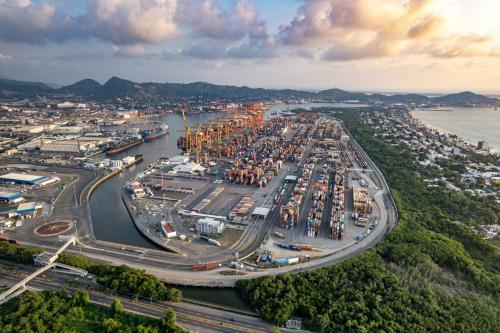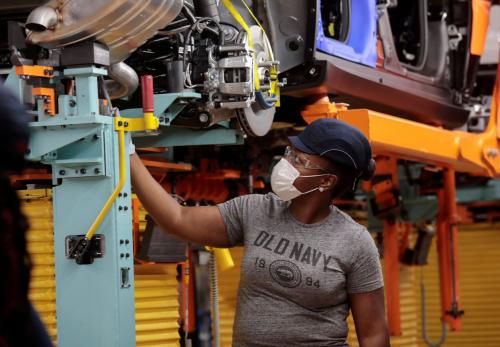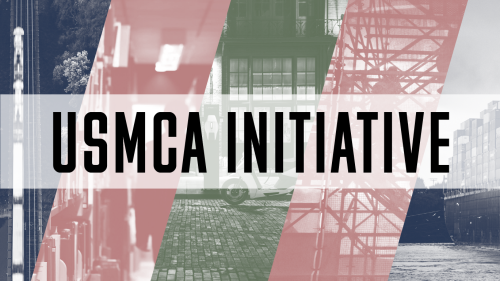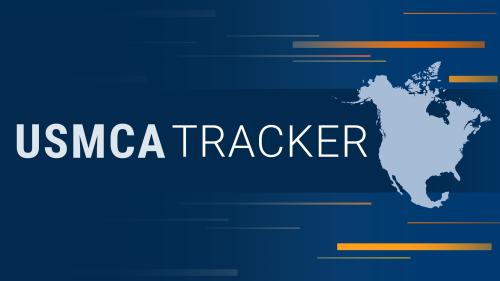2025
As the United States, Mexico, and Canada begin discussions in the run-up to the 2026 review of the United States-Mexico-Canada Agreement (USMCA), this compilation of expert papers aims to identify areas where strengthening U.S. cooperation with Canada and Mexico can advance key economic and national security goals for the United States—and where USMCA reform can help.
This year’s contributions coalesce around three key areas:
- Securing the supply of critical minerals and rare earth in North America.
- Building globally competitive electric vehicles and batteries in North America.
- Securing North American leadership in artificial intelligence.
Explore these themes below through chapters with scholarly analyses of critical issues, complemented by opinion-based “viewpoints” from leaders in business, government, and civil society with a stake in the future of the USMCA.
Watch the launch event
Introduction
This report comes at a time when economic relations between the United States, Canada, and Mexico are particularly fraught. Joshua P. Meltzer and Brahima S. Coulibaly take stock of North American relations at the start of the second Trump administration, assess USMCA achievements and challenges to date, and introduce the themes of this year’s report.
Back to the brink: North American trade in the 2nd Trump administration
As U.S. President Trump begins his second term, North American trade watchers are no longer asking simply whether the United States-Mexico-Canada Agreement will be extended come 2026 but whether it will even make it through 2025. C.J. Mahoney considers possible outcomes for USMCA under the second Trump administration.
Related viewpoints

Marcelo Ebrard Casaubon
March 5, 2025

Liz Shuler
March 5, 2025

Candace Laing
March 5, 2025
Establishing a critical minerals club across North America
In the area of critical minerals, U.S. ambitions to diversify supply chains and reduce dependence on China will mean working closely with allies and partners throughout the world. Bentley B. Allan proposes the U.S., Canada, and Mexico pursue a modern joint industrial policy on critical minerals as a bulwark against China’s dominance in international mining.
Related viewpoint

Jérôme Pécresse
March 5, 2025
Broad support for prioritizing responsible critical minerals development
Critical minerals are increasingly essential components of economic security, clean energy transitions, and advanced manufacturing for the United States, Canada, and Mexico. Tom Moerenhout explains how the USMCA can provide both a forum and a legislative framework to strengthen North American cooperation around these critical minerals.
Staying in the fast lane: Why North America can’t afford to slow down on electric vehicles
The automotive industry is deeply integrated across the three USMCA countries as a driver of trade and jobs, but it has also faced many challenges. Diana E. Páez considers how the USMCA can support the industry’s competitiveness in the economic opportunity presented by the transition to electric vehicles.
Related viewpoint

Leila Aridi Afas
March 5, 2025
Securing the minerals for North American energy
The clean energy transition will require a significant quantity of minerals. Melissa Barbanell, Cait O’Donnell, and Briana Fowler-Puja outline ways for North America to become more self-sufficient and responsible in its mineral sourcing as it pursues energy transition.
Building a long-term North American semiconductor ecosystem
The International Technology Security and Innovation (ITSI) Fund, managed by the U.S. Department of State as part of the CHIPS and Science Act, aims to facilitate collaboration with international partners to enhance global semiconductor supply chain security and diversification. Paul Triolo considers the future of the program under Trump and how it can help foster and develop a North American ecosystem for semiconductor manufacturing.
Related viewpoint

Judy Marks
March 5, 2025
The role of policies on technology and AI for innovation and increased competitiveness in North America
North America currently holds a dominant position in the growing global artificial intelligence market, but China has emerged as a fierce competitor. Claudia del Pozo and Daniela Rojas explain how by harnessing the collective strength of its three member nations, the USMCA can position the region as an unparalleled leader in AI.
Related viewpoint

Pedro Casas-Alatriste
March 5, 2025
More on USMCA

Measuring the effectiveness and implementation of the USMCA, as well as its impact on the policies and economies of the partner nations through forward-looking research, data, and analyses

Explore the latest data on trade, investments, meetings, and trade disputes

Analysis by Joshua P. Meltzer on the effects of tariffs on economic growth, jobs, exports, and inflation in the United States, Canada, and Mexico
Acknowledgements
The Brookings Institution is a nonprofit organization devoted to independent research and policy solutions. Its mission is to conduct high-quality, independent research, and based on that research, provide innovative, practical recommendations for policymakers and the public. The conclusions and recommendations of any Brookings publication are solely those of its author(s), and do not reflect the views of the Institution, its management, or its scholars.
The USMCA initiative gratefully acknowledges the support of donors including but not limited to the co-chairs, Brookings Trustee Paul Desmarais and Brookings International Advisory Council member Pablo González, as well as Brookings Trustee Victor Dodig, BNSF Railway, Brookfield Asset Management, Canadian Pacific Kansas City Limited, CIBC, George Weston Limited, the Greenbrier Companies, Magna Services of America Inc., McCain Foods, Rio Tinto, Saputo Inc., and TD Bank. Microsoft and Toyota, corporations with contributions in the report, are also donors to the Brookings Institution.
The editors would also like to take a moment to recognize the initiative’s late U.S. co-chair, Patrick Ottensmeyer. Pat was a strong advocate for advancing North American competitiveness, and his leadership and support of USMCA Initiative was invaluable to sustaining and expanding this work.
Brookings recognizes that the value it provides is in its absolute commitment to quality, independence, and impact. Activities supported by its donors reflect this commitment, and the analysis and recommendations are not determined or influenced by any donation. A full list of contributors to the Brookings Institution can be found in the Annual Report.








